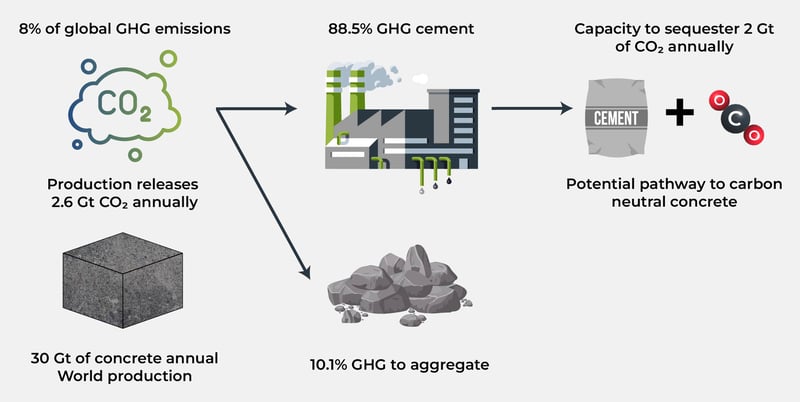Carbon Storage in Concrete Through Accelerated Carbonation.
Carbon Reduction Scientists Dr Gareth Davies and Dr Luan Ho wrote a whitepaper which has been published in Decarbonisation Technology.
With 88.5% of GHG emissions created from concrete during cement production, there is an urgency to develop technology for the industry to hit net zero targets.
Graphical Abstract

Article Summary
Concrete is the most widely used man-made material in the world by both weight and volume (Miller, et al., 2020). An estimated 30 Gt of concrete is produced annually, equating to more than 3.5 tonnes of concrete per person annually. The only material competing with concrete for production is fresh water, which is essential to human life. This should exemplify our reliance on concrete globally as a society.
Concrete is produced from a binder material (cement), non-porous minerals varying in size (aggregate), water, and low concentrations of admixtures (pigments, superplasticisers, and accelerating agents). It is estimated that concrete production alone contributes to 8% of anthropogenic greenhouse gas (GHG) emissions and 3% of global energy demand.
Figure 1 shows that an estimated 88.5% of the GHG emissions from concrete can be attributed to cement production, with the majority of the remainder coming from mining of aggregates (10.1%). Approximately half of these carbon emissions are from the combustion of fossil fuels to provide the energy to convert raw materials into cement (Gursel, et al., 2014). While challenging to develop and implement, there is a clear roadmap to eliminate this half of the emissions through the implementation of electrical kilns and the use of renewable energy.
However, the remaining 44.25% of the CO₂ emissions are from the calcination of limestone, which is intrinsic to cement production and currently unavoidable. Consequently, novel and innovative GHG mitigation strategies must be investigated, developed, and implemented quickly to mitigate the GHG emissions caused by the production of concrete. Only once technologies are developed can a true plan to net zero concrete be cemented into place.
Portland cement is the most widely used cement composition. It is made by heating limestone and clay materials in a kiln to form clinker, followed by grinding with gypsum (Aitcin, 2016). The most common version of Portland cement is a grey cement, appropriately referred to as ordinary Portland cement. In 2011, ~3 Gt of Portland cement was produced globally (Gursel, et al., 2014).
CO₂ emissions from the production of Portland cement totalled 2.6 Gt, of which 0.435 tonnes of CO₂ per tonne of Portland cement produced was emitted through calcination. Portland cement was developed in the early 1900s, so the chemistry and chemical nomenclature are old and mostly understood within the realm of civil engineering. It is primarily composed of calcium silicates, calcium aluminates, calcium sulphate, and calcium aluminoferrites. The composition of ordinary Portland cement (CPA 32.5) is shown in Table 1 alongside the traditional nomenclature and full chemical name.
It is fair to say that for most people who have laid concrete, water is added to the initial ready mix of cement, followed by the addition of aggregate to make a ‘wet’ cement, which then ‘dries’ to form solid concrete.
This is a misnomer as the water does not evaporate from the mixture at all; if significant evaporation were allowed to occur, this would lead to weak, undesirable concrete. Instead, there is a chemical reaction between the compounds in the cement (see Table 1) and the water.
This hydration reaction transforms dicalcium silicate and tricalcium silicate into calcium silicate hydrate and hydrated lime (also known as portlandite), as shown in Equation 1. The hydration reaction is the essential process that enables cement to harden, and hence concrete to transform from a liquid paste into a hardened product suitable for construction:
2[2CaO ∙ SiO₂] + 4H₂O ® 3CaO ∙ 2SiO₂ ∙ 3H₂O + Ca(OH)₂ (Eq 1)



.jpg?width=300&name=pexels-life-of-pix-2469%20(1).jpg)
.png?width=300&name=Decarbonisation%20Technology%20(2).png)